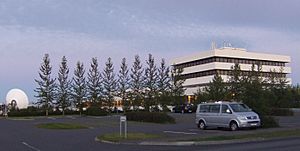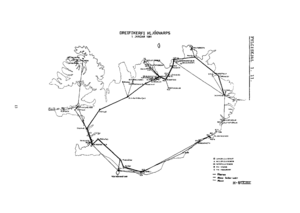RÚV facts for kids
 |
|
| Type | Television, radio and web |
|---|---|
| Country | Iceland |
| Availability | National; International via satellite (Thor 5) and online (selected programmes) |
| Motto | RÚV okkar allra (RÚV of all of us) |
| Revenue | 7.9 billion ISK |
| Net income | 174 million ISK |
| Headquarters | Reykjavík |
| Owner | State-owned |
| Key people | Stefán Eiríksson (director general) |
| Launch date | 1930 (incorporation; radio) 1966 (television) |
| Language | Icelandic |
Ríkisútvarpið (which means "National Broadcasting" in Icelandic), often called RÚV, is Iceland's main public broadcasting company. It's like the BBC in the UK or PBS in the USA, but for Iceland.
RÚV started in 1930. Its main offices are in Reykjavík, the capital city of Iceland. RÚV also has smaller offices in other parts of the country. It runs an online news service, which is one of the most popular websites in Iceland. In 2016, a huge 88% of people in Iceland used RÚV's content every week!
RÚV offers many different types of shows and programs. It has two main radio stations, Rás 1 and Rás 2. It also has a full-time TV channel called RÚV. Sometimes, there's a second TV channel, RÚV 2, for special events. RÚV also has online-only content, especially for kids and older people.
RÚV gets its money from a special government tax paid by everyone who pays income tax. It also earns money from advertisements shown on TV and radio. All of RÚV's content is free to watch or listen to in Iceland.
Contents
History of RÚV
The Icelandic National Broadcasting Service, RÚV, began its journey in 1930. This was when the Icelandic state radio, called Útvarp Reykjavík (which later became Rás 1), first started broadcasting. RÚV has been an active member of the European Broadcasting Union since 1956. This is a group of public broadcasters from across Europe.
Radio Broadcasting
Early Radio Days
Icelandic radio started broadcasting in 1930 from a place near Reykjavík. This first station was called Útvarp Reykjavík and later became Rás 1.
For many years, RÚV used special longwave radio signals. These signals were good for reaching far-off places. They helped fill in gaps where regular FM radio didn't reach. They were also very important for Iceland's fishing boats out at sea. Longwave signals also served as a backup during emergencies.
In 1991, a big longwave transmitter tower near Reykjavík fell down in a storm. A new, very tall longwave transmitter was then used from 1999.
However, by 2023 and 2024, RÚV stopped using longwave services. This was because most modern radios and cars no longer supported these signals. Also, they were not as good for emergencies anymore. The longwave transmitters were taken down, marking the end of longwave radio in Iceland.
RÚV also used shortwave radio signals for a while. These were for very long-distance broadcasts, mainly for sailors and Icelanders living abroad. Shortwave broadcasts stopped in 2007 when satellite broadcasts became available.
FM Radio Today
Regular FM broadcasting started in 1959. Over time, it spread across the whole country. Stereo sound for radio began in 1980.
In 1983, RÚV launched its second radio station, Rás 2. The first station was then renamed Rás 1. Because longwave broadcasts stopped, RÚV is now making its FM network even stronger.
In 2004, RÚV started a special music radio station called Rondó. It played only classical music and jazz without any talking. In 2020, Rondó stopped broadcasting on FM radio. But you can still listen to it online and through digital TV services.
Television Broadcasting
RÚV started its television broadcasts in 1966. Color TV shows began in 1977. In 1981, RÚV showed its first live programs from a satellite.
For a long time, RÚV was the only TV broadcaster in Iceland. But in 1986, other private TV companies started, and RÚV got some competition.
RÚV's teletext service, called Textavarpið, started in 1991. This service shows text information on TV screens, like news headlines or weather. It is still working today.
In May 2007, RÚV began sending TV signals directly to homes via satellite. This helped reach fishing fleets and remote areas that didn't get regular TV signals. This service stopped by mid-2025.
High-definition (HD) digital TV broadcasts started in 2013. These were sent over a new digital network. RÚV stopped broadcasting old-style analogue TV in 2015. Now, most people watch RÚV through internet TV services or online.
In 2021, TV broadcasts for the Reykjavík area moved to a new location. This ended 70 years of broadcasting from the old site.
What RÚV Shows
RÚV has a special job to do. It must "promote the Icelandic language, Icelandic history, and Iceland's cultural heritage." It also needs to "honor basic democratic rules, human rights, and the freedom of speech and opinion."
RÚV shows many programs about arts, media, and current events. It also provides entertainment like movies and popular TV shows. You can also watch sports, documentaries, and shows made in Iceland. There are many programs just for children too.
The RÚV news team creates news for both TV and radio. It is one of the most trusted news sources in Iceland. On weekdays, the Rás 2 radio station also has short local news updates for different regions.
Gettu betur is a very popular yearly quiz show. Teams from high schools across Iceland compete against each other. The rounds are shown on both radio and TV. Another popular event is the Eurovision Song Contest. RÚV has sent participants from Iceland to this contest since 1986.
In sports, RÚV usually shows big events like the Olympic Games and the FIFA World Cup. RÚV showed the 2010 World Cup tournament.
RÚV's Services
RÚV broadcasts two main TV channels and three radio stations. Each one is designed for a different audience. As a public service, RÚV also broadcasts a news bulletin in Icelandic Sign Language for people who are deaf or hard of hearing. The Rás 1 radio channel also gives detailed weather reports, which are very helpful for Icelandic sailors.
Television Channels
- RÚV Television (also called Sjónvarpið) – This is the main channel with all kinds of programs.
- RÚV 2 – This channel is used for special events and doesn't broadcast all the time.
- KrakkaRÚV – This is an online service especially for children and young people. It started in 2015.
If you watch RÚV TV channels online from outside Iceland, you can only see some programs. This is because of special rules about broadcasting rights.
Radio Stations
- Rás 1 (Channel 1) – This station focuses on news, weather, current events, and culture.
- Rás 2 (Channel 2) – This station plays pop and rock music.
- Rondó – This station plays non-stop classical music and jazz. It's available through digital TV and online.
How RÚV Reaches You
Today, most people in Iceland watch or listen to RÚV using the internet. However, FM radio is still very popular. About 30% of Icelanders listen to Rás 1 and 61% listen to Rás 2 every week. This is partly because many people in Iceland own cars, and they listen to the radio while driving.
Radio Distribution
RÚV's radio stations, Rás 1 and Rás 2, are broadcast on FM radio. They use a network of 230 FM transmitters across the country. RÚV plans to make its FM network even stronger.
The radio stations are also available through digital TV services and online radio. Iceland does not plan to use DAB radio, which is another type of digital radio.
Television Distribution
The RÚV and RÚV 2 TV channels are broadcast in high definition (HD) using a digital network. These broadcasts are free to watch and reach almost all of Iceland's population. However, a survey in 2022 showed that only 1% of people use these traditional broadcasts to watch RÚV.
Because many homes in Iceland have fast internet, most people watch RÚV through the internet. RÚV is available through internet TV systems from companies like Síminn and Vodafone. RÚV also offers all its content on its website. You can also watch RÚV using apps on devices like Apple TV and Android phones.
If you are in Iceland, the online broadcasts are open and free. But some programs are not available internationally due to licensing rules. If you have an Icelandic digital ID, you can log in to get full access to broadcasts from anywhere.
| How people watch | How many people use it |
|---|---|
| Traditional digital broadcasts | 1% |
| Internet TV box (from Síminn/Sýn) | 64% |
| Online streaming apps (like Apple TV app) | 27% |
| RÚV Website | 7% |
| Other ways | 1% |
See also
 In Spanish: RÚV para niños
In Spanish: RÚV para niños
- List of Icelandic television channels
- Television in Iceland
- RÚV (television channel)
- Rás 1
- Rás 2
- Telecommunications in Iceland
- Internet in Iceland





